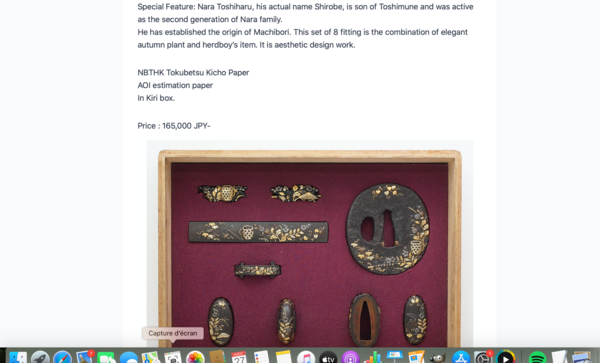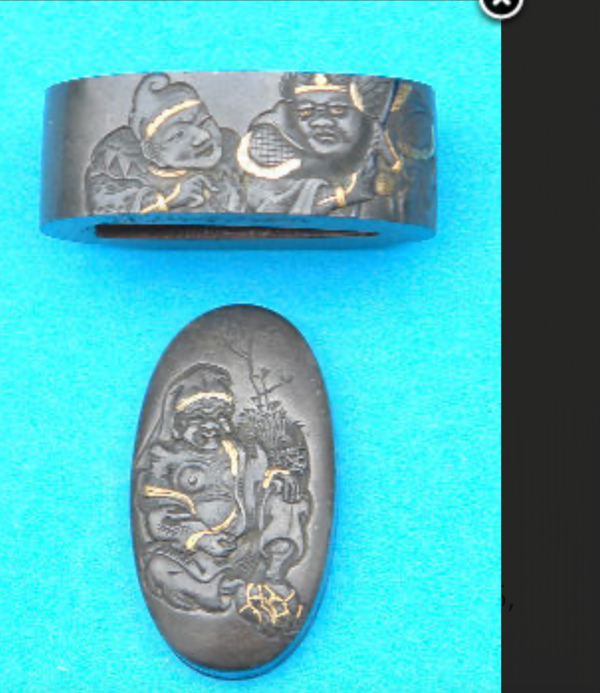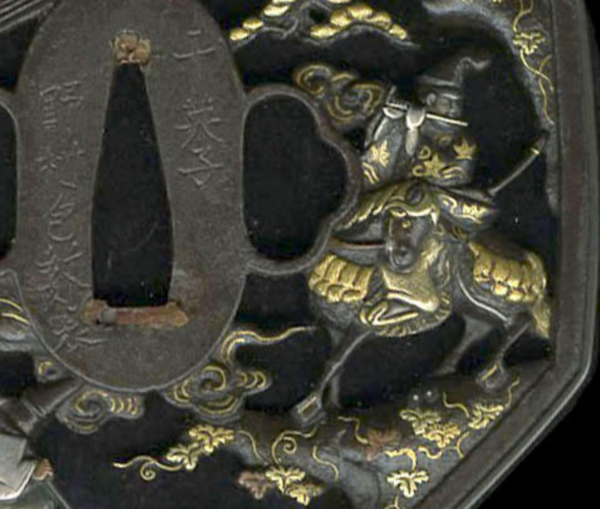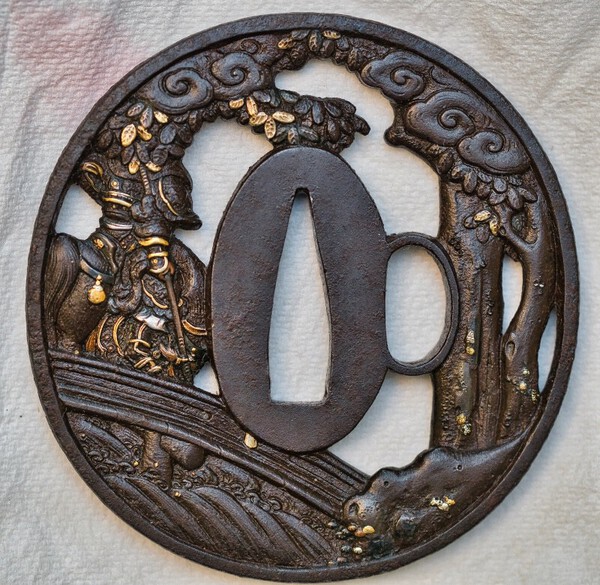
DanielM
Members-
Posts
52 -
Joined
-
Last visited
Content Type
Profiles
Forums
Events
Store
Downloads
Gallery
Everything posted by DanielM
-
Many many thanks SteveM...realy you are of a great help for this forum I wish you all the best Daniel
-
Please could somebody help me translating, identifying a signature of a tsuba....all I can say it is a shibuishi end Edo or Meiji tsuba....many thanks in advance Daniel
-
Hello David, This tsuba seems effectively very interesting, your photo shows very well the tekotsu. What is your opinion concerning the design? it looks more or or less similar to a tsuba that was offered for sale by Gold Tier a few months ago ...I join a screen shot of it? Thanks for your comments Daniel
-
Thank you Chris and Mauro it is probably an unrecorded artisan end 19th century. thanks again and all the best Daniel
-
Many thanks Jean....I go for Kazu Masa All the best Daniel
-
Hello, Could anyone please help me translating a tsuba signature…I suppose it is in soshu script. 3 kanji: Ichi (or I. or kazu). /. ? / Tsukuru? It is on an iron tsuba. Most probably end EDO. Voluntary corroded to imitate old Katsushi tsuba? Many many thanks in advance
-
Hello Jeremy, Thanks for the advice....I will do that Cheers
-
Hello, Could anyone please help me translating a tsuba signature…I suppose it is in soshu script. 3 kanji: Ichi (or I. or kazu). /. ? / Tsukuru? It is on an iron tsuba. Most probably end EDO. Voluntary corroded to imitate old Katsushi tsuba? Many many thanks in advance
-
Incredible, many many thanks to Dale, SteveM and Piers D. you are really of great help. ...
-
Hello members In the past you have been of good help translating a signature on one of my tsuba…So I have another one and if you could help identifying the maker or the school that would be marvelous It is iron decorated in kebori not very often seen on iron…well finished with a thiner edge Many many thanks in advance Daniel
-
Dear Paul As you said "If this piece was really made by Nara Toshiharu it would be worth a fortune " and I agree with you so I tried to find references on internet and I find at Aoi Art ...8 pieces of kodogu made by Toshiharu...with NBTHK certificate...Tokubetsu Hozon for about 1500€...??? there is something wrong somewhere? What do you think?
-
Many thanks for your help Paul and MauroP. Inside this box there is a Fuchi and a Kashira Nara school but the quality is not the one of that master.... thank you for your quick reply...it is veery helpfull Best regards to you
-
Hello, I would be very grateful if you could help me translating an inscription on a box containing a Fuchi and a Kashira I join 2 photos of the inscription - I have no other photo as I have not yet bought this item - it could depend of the translation.... Many many thanks in advance
-
Many many thanks for your time SteveM, I will take the regular name Yamayoshi Katsu...it sounds nice Japanese linguage is very difficult...but their works are so beautifull..even if we understand only a little part... All the best Daniel
-
Hello Samouraijack, It looks like ko kinko sanmai tsuba is the reverse side similar? if you look at the Nakago ana do you see the 3 layers? But it is possible also a ko kink plain Shakudo... Interesting tsuba anyway
-
Hello, May I ask your help for the translation of a Mei on a kozuka and if possible to identify the artisan. Many many thanks in advance It is a very simple red copper kozuka with the head of Daruma and on the back side we have on the upper right …I read (but I am maybe wrong) Miya +Moto +Mu +Sashi +? +? +I (meaning = intention) This is I supose a tribute to a painting of Daruma that Musashi did when he was old. In the lower left …it is much more difficult for me Yama(or San) +Hoo (or Kanba) +Ichi (or itsu). +Tsukuru I have no idea about this artisan? Many thanks for your help Daniel
-
Yes I was a little bit surprised of the "non" response about this topic..;but I suppose it is a difficult subject? anyway I thank you very much Dan Tsuba and Matsunoki...for their proposals. I will thus investigate these 2 suggestions. Legend in Japanese art from Holy is effectively a very good book...unfortunately I sold it a few years ago...because I have the Ko ji Hoten. also interesting. and possibly more complete? ...but I did not find the 3 man (or woman?) in it... Again thank you for your research All the best Daniel
-
Could anyone tell me what is the signification of this design? Chinese general? or? Many many thanks in advance
-
Daimyo aikuchi I would like to share with you an interesting discovery that i tryed to place into its historical context….any comments is welcome. It is a Daimyo aikuchi koshirae, with a simple black laquer saya decorated in gold laquer with cherry flower and a phenix bird all with fine details. The tsuka with samé without lacing and 2 round menuki with a central dragon and six Kirimon. And a sober Futakoromono with Kozuka and Kogai Kyo Goto school Suisen no zu (Daffodil design) The real interest concern the Kashira, the Fuchi/Koiguchi, the Kogiri and the Kurigata, in simple black horn but decorated in gold laquer with 2 Mon on each ..the « Kuro Mochi Tate Mokko » and the « Tanoji » they are the primary and secondary Mon of the Clan « Hotta from Sakura ». I suppose that the union of these 2 Mon is due to a special event..as a marriage or an anniversary or an important birth….as normaly for the day to day wear only the primary mon is in use. The Hotta from Sakura is not a very old clan, founded by Hotta Masamori in around 1626 thanks to his relation with the nurse of the Shogun Iemitsu (Lady Kasuga) It is also not a great clan with high revenue but as this is a mid to end Edo period koshirae it has most probably belongued to Hotta Masayoshi (1810-1864) or his son. This is the 5th Daimyo of Sakura and an important political person He was one of the principal of the « Rangaku » it is an organisation in charge of the study the knowledges of the Holland people residing in Deshima – more specificaly the medicine, the astronomy and the military equipment (let us remember that the Holland people are the only foreigners authorized to commerce with Japan from 1641 to 1853) He is a supporter of the opening of Japan (in 1853-1854 Commodore Perry and the black ships...try to force contact with Japan) 1855 Masayoshi is at the head of the « Roju » replacing Abe Masahiro. He is now the principal adviser for the Shogun, control the relations between Nobles and the different Daimyos.) He is also in charge of the diplomatic contact with the american Townsend Harris and will be a co-signer of the Harris Treaty (without obtaining the agreament of the Emperor Komei (in favour of the joi faction – wanted to expell the foreigners by force if necessary….) At that period the shogun is Iesada, he is very ill and its succession give rise to a struggle between 2 factions… With these issues unresolved Hotta was replaced by Ii Naosuke Hotta Masayoshi resigned his posts in favour of his son but continued to support the Hitotsubashi partisans for the succession of the Shogun, which was opposed to Ii Naosuke and during the Ansei, purge of Hitotsubashi partisans, Hotta was placed under house arrest...where he died in 1864. Hotta Masatomo 6th Daimyo of Sakura, a son of Masayoshi had also some problems as during the Boshin war he was partisan for the Shogun...and as we know it is the Emperor faction that win the battle… So we can understand that Hotta Masayoshi and his son where after a rather glorious period not very happy at the end...and probably in financial difficulties...and having priviledged contact with Holland people...they could have sold this (or given) this aikuchi to one of these barbarian...i know it is speculation but as a coincidence ? this aikuchi was discovered in an old Holland province ….where it was possibly kept in a Holland family for several generations….but ...maybe the reality is totaly different...who knows….thanks for reading.
-
- 4
-

-
Hello Oleg,
You probably remember the Tsuba with general Zhang Fei on horse on the Chohan bridge. You said 100% Soten and I did not agree....
Now I think you were probably right because I discovered a Nomura tsuba with many similarities (mainly the attitude of the horse) Nomura school is issued from the Soten....so please accept my excuses
-
Hello Ckaiserca, Very nice koshirae ...congratulation. I have not seen this design very often on kodogu….but more often on chinese porcelain…. That is what i found about its symbol In Japan, its crowing, associated with the raucousness of the deities, who lured Amaterasu, Goddess of the Sun, out of the cave where she had been hiding. Courage is the virtue that the Japanese (like other Far Eastern peoples) attribute to the rooster. The white cockerel as an auspicious symbol Japanese Shinto or shrine tradition likely has its origin in Taoist practices that filtered through from the Chinese court during the Tang dynasty and Nara periods. Chickens are thought of as errand messengers of the gods at the Isonokami Shrine where many sacred roosters are seen roaming. Thanks for showing us Daniel
-
Thank you Geraint, i also realy love this piece. We realy feel the atmosphere in this tsuba. Such details in iron work...it is unbelievable...I think the most difficult for such work is to render the exact expression of the face..here ( in copper) it is very effective and i am astonished by very tiny details you nearly cannot see with naked eyes...just another exemple the head of the spear...a lion head….2 mm it has been done with a magnification glass i suppose...and tiny honzogan less than 0.5 mm… I join the photo of the other side ...for the pleasure…. Thank you to all of you who have help me…. Daniel
-
Again many many thanks to SteveM and to Kyle....I am totally happy you could identify the maker and period of this tsuba...I will care for it.... all the best Daniel
-
Hello Kyle, Many thanks for the translation of the signature..it is wonderfull...very kind of you Kyle. I also thank Oleg for the possible school...i agree it looks Soten...but i am not convinced. I am maybe wrong but i think Soten is generaly signed in the classic way (even if not made by Soten school) Soshu Hikone ju Soheishi...Soten…. Or it is not signed at all ..but not like just the name as here « Hiroshige zu » Soten design is more stiff less fluid than this one..less balanced .Soten use very often nunomezogan...the iron surface of Soten tsuba is also generaly not so well finished…for ex the details in the bark of the tree... So ..but again i am maybe wrong...i would prefer Aizu Shoami (who have done Soten style) or (Sukashi) Tetsugendo… if a member could comment this opinion ? Thanks in advance Daniel
-
I am new on this forum and i have only few knowledge about Tosogu so I would be very pleased to receive some help in the translation of the signature on this tsuba and its school if possible. I liked this Maru Bori Sukashi tsuba of the horse and rider. It is a wakizashi tsuba in iron Maru gata 72 mm diam and 5 mm thickness at the sepia and 4mm at the rim. The seller mentionned samourai on horse...but this is the famous chinese general « Zhang Fei » from the 3 kingdom tale…. I discovered an interesting Ukiyoe representing the same scene « Zhang Fei with an hallucinated look..defending alone the passage of a bridge against a complete army…. » The mimi was slightly rusted but the plate itself doesnt seems to have suffered.. There are plenty of thiny details...some are so fine that you have to use a magnification glass to appreciate...…such work I suppose is end EDO Thank you in advance for any comments…..and happy new year to all of you. I guess. Signature. Hiro +?+? Daniel




















